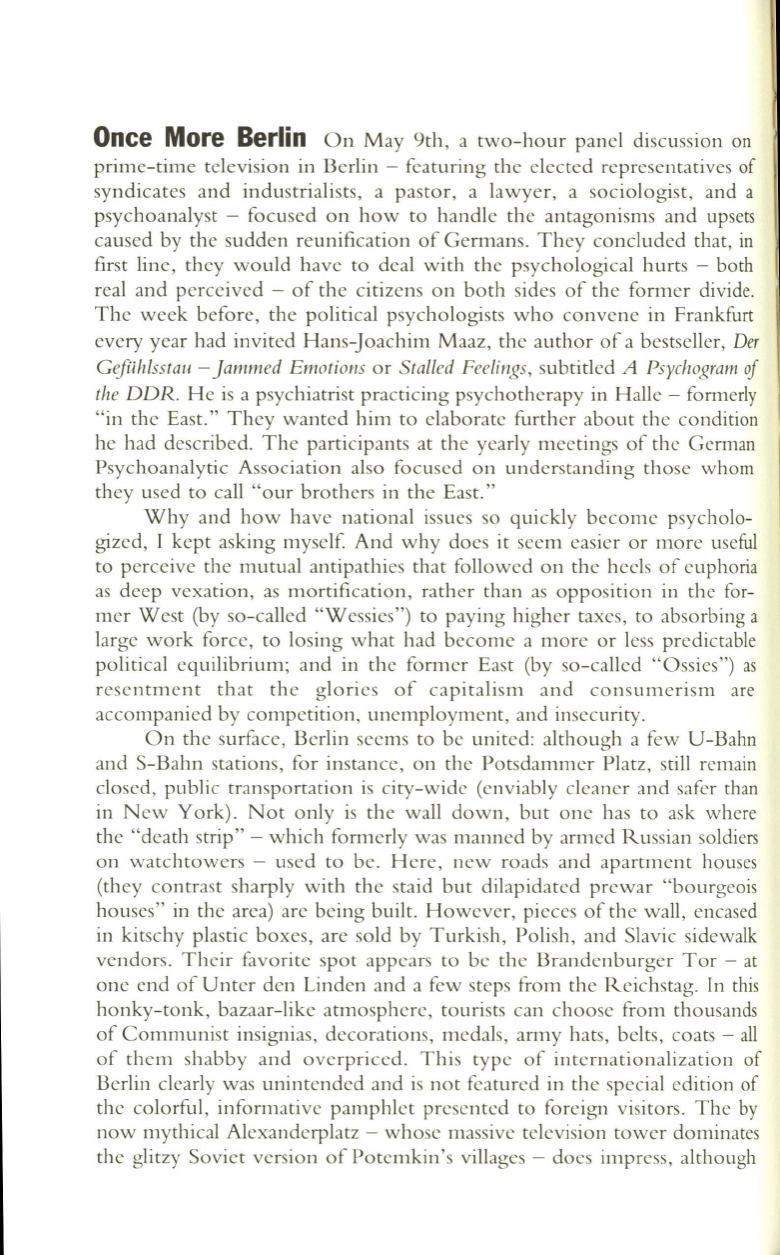
Once More Berlin
On May 9th, a two-hour panel discussion on
prime-time television in Berlin - featuring the elected representatives of
syndicates and industrialists, a pastor, a lawyer, a sociologist, and a
psychoanalyst - focused on how to handle the antagonisms and upsets
caused by the sudden reunification of Germans. They concluded that, in
first line, they would have to deal with the psychological hurts - both
real and perceived - of the citizens on both sides of the former divide.
The week before, the political psychologists who convene in Frankfurt
every year had invited Hans-Joachim Maaz, the author of a bestseller,
Der
CeJiihlsstau
-
Jammed Emotions
or
Stalled Feelings,
subtitled
A Psychogram of
the DDR.
He is a psychiatrist practicing psychotherapy in Halle - formerly
"in the East." They wanted him to elaborate further about the condition
he had described. The participants at the yearly meetings of the German
Psychoanalytic Association also focused on understanding those whom
they used to call "our brothers in the East."
Why and how have national issues so quickly become psycholo–
gized, I kept asking myself. And why does it seem easier or more useful
to perceive the mutual antipathies that followed on the heels of euphoria
as deep vexation, as mortification, rather than as opposition in the for–
mer West (by so-called "Wessies") to paying higher taxes, to absorbing a
large work force, to losing what had become a more or less predictable
political equilibrium; and in the former East (by so-called "Ossies") as
resentment that the glories of capitalism and consumerism are
accompanied by competition, unemployment, and insecurity.
On the surface, Berlin seems to be united: although a few U-Bahn
and S-Bahn stations, for instance, on the Potsdammer Platz, still remain
closed, public transportation is city-wide (enviably cleaner and safer than
in New York). Not only is the wall down, but one has to ask where
the "death strip" - which formerly was manned by armed Russian soldiers
on watchtowers - used to be. Here, new roads and apartment hOllses
(they contrast sharply with the staid but dilapidated prewar "bourgeois
houses" in the area) are being built. However, pieces of the wall, encased
in kitschy plastic boxes, are sold by Turkish, Polish, and Slavic sidewalk
vendors. Their favorite spot appears to be the Brandenburger Tor - at
one end of Unter den Linden and a few steps from the Reichstag.
In
this
honky-tonk, bazaar-like atmosphere, tourists can choose from thousands
of Communist insignias, decorations, medals, army hats, belts, coats - all
of them shabby and overpriced. This type of internationalization of
Berlin clearly was unintended and is not featured in the special edition of
the colorful, informative pamphlet presented to foreign visitors. The by
now mythical Alexanderplatz - whose massive television tower dominates
the glitzy Soviet version of Potemkin's villages - does impress, although


